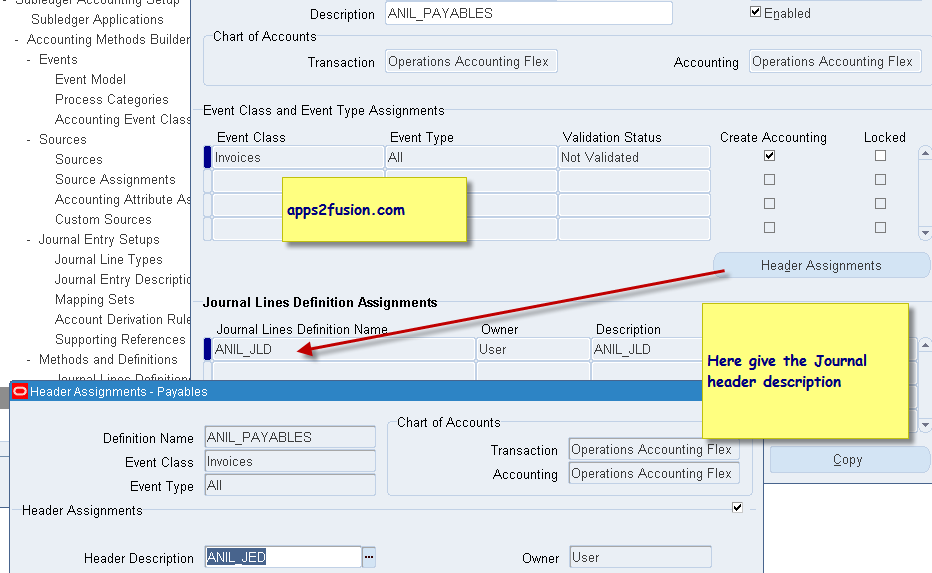In the previous part of this SLA article, you have learnt creation of the Journal Line Definition. Now it is time to create AAD, which is "Application Accounting Definition".
The purpose of AAD in SLA is to dictate which "Journal Line Definition" must be used when a specific event takes place against a specific type of transaction in a specific module like Payables or Receivables. If you recollect, the "Journal Line Definition" definition creates a Credit Line and the Debit Line of a Journal.
Oracle ships out of the box an AAD for every simply module/application that uses SLA.
Hence for each application like AP,AR,PA,PO etc there will exist an existing AAD in the Subledger Modules. However, for this example we will create a new AAD for Payables.
In the previous article you created a Journal Line Definition that is responsible for constructing a Journal. However, in AAD screen you will specify when the Journal Line Definition will be used. In this case, as per the image below, we are stating that journal line definition ANIL_JLD should be used for creating journal whenever any event occurs against an Invoice in Payables.

You can also click on "Header Assignment" button in AAD to attached "Journal Entry Description" [JED] which dictates how the Journal Header description will be constructed. If you recollect, in Journal Entry Description, we concatenate static text and dynamic content from SLA Sources[mapped to DB columns or pl/sql functions] so as to construct a description for Journal Line or Journal header.

In this article we have seen that AAD is created for each module. However, in any implementation there is a need to perform accounting for all the modules. "APPS2FUSION UK" might be running Payables and Receivables and also Project Accounting. Hence we need to create a SLAM-Subledger Accounting Method.
Using AAD we specify the Journal creation rules per module. In SLAM we specify how the Journals must be built for the entire organization "APPS2FUSION UK" across Payables and Receivables and Project Accounting. The company "APPS2FUSION UK" will have a legal entity in UK, and hence the SLAM will be attached to the UK Legal Entity.
The purpose of AAD in SLA is to dictate which "Journal Line Definition" must be used when a specific event takes place against a specific type of transaction in a specific module like Payables or Receivables. If you recollect, the "Journal Line Definition" definition creates a Credit Line and the Debit Line of a Journal.
Oracle ships out of the box an AAD for every simply module/application that uses SLA.
Hence for each application like AP,AR,PA,PO etc there will exist an existing AAD in the Subledger Modules. However, for this example we will create a new AAD for Payables.
In the previous article you created a Journal Line Definition that is responsible for constructing a Journal. However, in AAD screen you will specify when the Journal Line Definition will be used. In this case, as per the image below, we are stating that journal line definition ANIL_JLD should be used for creating journal whenever any event occurs against an Invoice in Payables.
You can also click on "Header Assignment" button in AAD to attached "Journal Entry Description" [JED] which dictates how the Journal Header description will be constructed. If you recollect, in Journal Entry Description, we concatenate static text and dynamic content from SLA Sources[mapped to DB columns or pl/sql functions] so as to construct a description for Journal Line or Journal header.
In this article we have seen that AAD is created for each module. However, in any implementation there is a need to perform accounting for all the modules. "APPS2FUSION UK" might be running Payables and Receivables and also Project Accounting. Hence we need to create a SLAM-Subledger Accounting Method.
Using AAD we specify the Journal creation rules per module. In SLAM we specify how the Journals must be built for the entire organization "APPS2FUSION UK" across Payables and Receivables and Project Accounting. The company "APPS2FUSION UK" will have a legal entity in UK, and hence the SLAM will be attached to the UK Legal Entity.
No comments:
Post a Comment